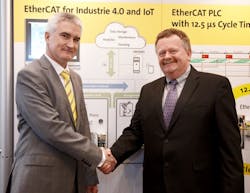Hannover Fair is not only the largest industrial technology tradeshow of its kind, it remains one of the few events at which numerous new technology releases are introduced. Though reserving the release of new products for tradeshows has faded dramatically over the past decade, events such as Hannover Fair are increasingly being used to promote partnerships between companies.
As a case in point, two new alliances were highlighted at this year’s event: 1) EtherCAT Technology Group’s (ETG) work with the OPC Foundation to develop common interfaces for Industry 4.0 and Industrial Internet of Things applications; and 2) Bosch Rexroth’s partnership with National Instruments (NI), in which NI’s LabView graphic programming system can now be used to program Bosch Rexroth’s electric and hydraulic drives using Bosch Rexroth’s Open Core Engineering platform.
The ETG/OPC UA announcement focuses on the need for seamless and continuous communication through all layers and levels within the digital factory, as well as externally through cloud-based services and Internet technologies in Industry 4.0 and Internet of Things-related applications. The ETG and the OPC Foundation alliance will center on developing a common definition of open interfaces between the two groups’ technologies. According to the Memorandum of Understanding—signed by ETG and OPC Foundation at Hannover Fair 2015—the two groups will work together to develop these open interfaces, rather than focusing on their own technology extensions into the core area of the other.
Facilitating this agreement is the complementary nature of ETG’s and OPC Foundation’s technologies. EtherCAT is a real-time Ethernet fieldbus for machine and plant controls, leveraging the EtherCAT Automation Protocol (EAP) for data exchange between masters; and OPC UA is a platform for scalable communication with integrated security that enables encrypted data transfer up to MES and ERP systems and into the cloud.
“OPC UA is not a competitor of fieldbuses,” noted Tom Burke, president and executive director of the OPC Foundation. “It (OPC UA) seeks to enable the consistent, safe, and scalable communication of such systems into the IT world. Thanks to the common development of interfaces between both our associations, we expect quick and practice-oriented results.”
The Bosch Rexroth/NI announcement also broke new ground, not only in terms of a new partnership for Bosch Rexroth and NI, but in how NI’s LabView software can be used. Historically, LabView has been used to program machines that record and analyze measurement data for tasks such as inline quality control or machine status monitoring. Automation tasks, such as the precise positioning of a test piece, typically require use of a PLC programmed in a separate programming language, typically an IEC 61131-3 standard language. However, using Rexroth's Open Core Engineering interface technology, measurement and testing programming, as well as all PLC programming, can now be done via LabVIEW without having to write PLC code.
The joint Bosch Rexroth/NI LabView package permits the controlling of electric and hydraulic Rexroth drives in real time. In addition, the ability to program and control these drives in LabView using Open Core Engineering means that the drives no longer need a control unit. Instead, the Rexroth drives can be controlled directly from LabView—which also records functional data from the drive. Speaking about this joining of computer software and drive control functionality, Dr. Karl Tragl, president of the executive board of Bosch Rexroth, noted that this capability provides an inexpensive way for users to explore Industry 4.0 applications in which machine operations are digitally controlled, recorded and connected.
For an explanation of Open Core Engineering, which uses open IT programming for industrial control applications, watch the video below from Bosch Rexroth.
Leaders relevant to this article:


